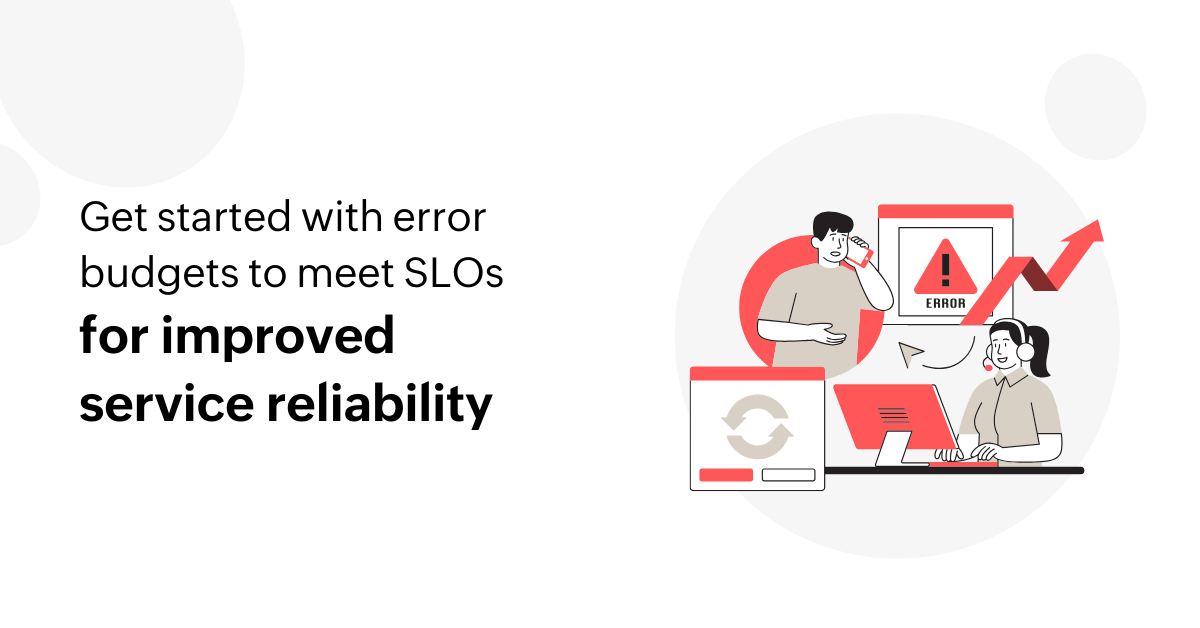How to get started with error budgets to meet SLOs for improved service reliability

- A clear description of how each service level is measured
- Metrics like availability, downtime, response time, and errors
- Target or acceptable values such as 99.95% uptime
- A timeframe for which the SLOs will remain valid and which is subject to revision
Error budgets in IT
SLOs also mark the maximum error amount or period a system is allowed to experience within a timeframe to be judged as acceptable. Akin to a financial budget, an error budget expresses the things gone wrong (errors) as a percentage of the total time or requests that transpire in a timeframe: for example, 1% of monthly requests, 0.05% of daily payments, or 0.01% of cloud storage uploads.
Bridging the gaps
Robust IT observability is essential to operationalizing SLOs and error budgets. Observability goes beyond traditional monitoring by providing deep visibility into system performance through metrics, logs, and traces. It answers not just “Is the system down?” but “Why is it down, and how can we prevent it next time?”
However, as systems scale, manual monitoring becomes impractical. This is where artificial intelligence for IT operations (AIOps) in IT observability helps. AIOps uses machine learning capabilities to sift through large datasets, detect anomalies, and predict potential SLO breaches. For instance, when a sudden spike in error rates threatens to exhaust the error budget, AIOps correlates it with a recent deployment or infrastructure change, enabling proactive resolution. By bridging gaps between current performance and SLOs, AIOps helps you achieve your SLOs without stressing your IT folks.
Site24x7: Empowering proactive IT reliability
Site24x7 is an AI-powered full-stack observability platform that offers comprehensive monitoring capabilities to help you optimize the performance of applications, servers, networks, and cloud services. This overarching, all-encompassing coverage serves as a single platform for you to focus and align your operations to meet your SLOs.
Additionally, you can leverage Site24x7’s detailed reports and trend analysis to chart your error budgets and track your progress as you go. The platform helps you stay aware of how you are progressing by answering questions like "Are you burning through your error budgets too quickly?" For example, when your errors exceed half of the permissible monthly limit within the first week, it's time for a discussion on how to act by adjusting your priorities accordingly. This proactive stance is better than passive firefighting.
5 tips to get started
Here are five ways you can go about setting meaningful SLOs, calculating error budgets, and using IT observability:
- Define meaningful SLOs: Collaborate with stakeholders to set SLOs based on user expectations and business needs. For a payment gateway, this might mean 99.9% of transactions succeed within one second.
- Calculate error budgets and break them down to grasp them completely: Translate SLOs into error budgets. For example, a 99.9% uptime SLO over 30 days allows for only 43 minutes of downtime, which is your error budget, giving you the context within short, actionable timeframes.
- Instrument observability: Use tools like Site24x7 to monitor key metrics and establish baselines.
- Leverage AIOps: Use AI to proactively find and eliminate anomalies in your resource consumption patterns, especially from a troubleshooting perspective. Event correlation and forecasting help you prevent issues ranging from application crashes to mild latency that could snowball. Since these situations affect your SLOs, it is essential to eliminate them using IT automation. Even performing a simple server restart or provisioning in time could save your application or website from crashing during critical junctures.
- Review and iterate: Regularly assess SLO compliance and adjust targets or budgets as systems evolve.
Try Site24x7
By focusing on setting sharp SLOs and using IT observability to meet them, organizations can improve service quality, use the metrics to optimize the available resources to reduce downtime and errors in every stage, and ensure customer satisfaction for sustained success. Take Site24x7’s AI-powered full-stack observability platform for a spin today and discover the platform’s ability to aid you in every stage of your error budgeting and assist your IT operations teams in meeting their SLOs every time.
Topic Participants
Ramkumar Ramaswamy